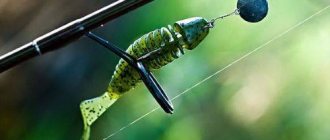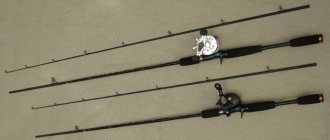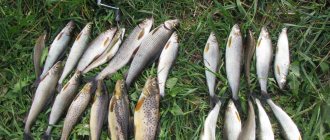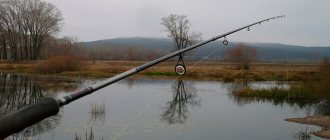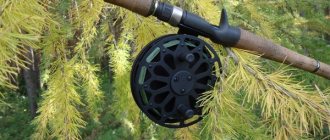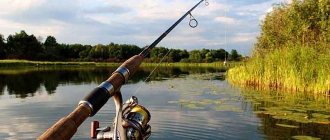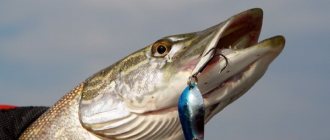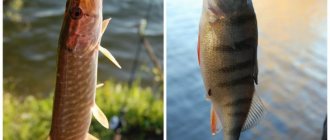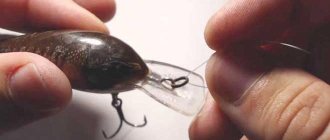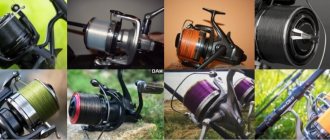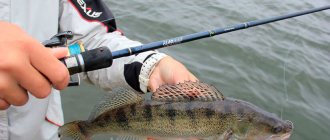What is twitching
Twitching is fishing with a spinning rod using wobblers with special jerks, the purpose of which is to make the plastic imitation of live bait indistinguishable from a real fish in order to mislead and catch pike, perch and other predators.
Standard postings of this type: moving the wobbler up and down or from side to side with jerks of the rod that are inconsistent in amplitude, frequency, and strength. As a result, the predator should get the impression that the bait has the main difference between living creatures and inanimate objects: the unpredictability of the direction and speed of movement. The main tasks of an angler when twitching are to understand for himself what and why is required of him to achieve success, choose the right gear for this and correctly apply it when fishing. When choosing a spinning rod and its equipment, he must take into account the following factors:
- The tackle should provide maximum aggressiveness and the possibility of quick variations of wiring;
- Ensure that the wobbler is immersed to the greatest possible depth;
- Be adapted to the nature and weight of the bait;
- The current speed in a particular body of water must be taken into account.
Choosing a reel for installation on a jig spinning rod
When assembling gear, you should always remember that there is no such thing as an unimportant detail. This statement also applies to the choice of reel. They come in three types - inertia-free, inertial and multiplier. It is difficult to say which type to give preference to, since, as in the case of a fishing rod, you need to navigate based on the requirements for fishing conditions.
- A spinning reel in a jig tackle. Due to ease of use and reliability, this type of reel has earned enormous popularity among anglers. When choosing, first of all, you should pay attention to the assembly quality of the arch elements: the laying roller must have a bearing in its design to avoid the formation of cuts on it by the fishing line, and is also protected by a special coating (for example, titanium). It is desirable that the bobbin of the reel also have such protection. It is necessary to have an instantaneous stopper mechanism for the overrunning clutch, which allows you to save the moving elements of the reel from wear when catching a large specimen, taking on the entire load. An endless screw system is used to lay the fishing line turn to turn. As in the case of fishing rods, the leading manufacturers are Daiwa and Shimano (DaiwaTD-SOL, Team Daiwa Advantage 4000, DaiwaCertate Hyper Custom 3000, Shimano Stella 4000, Shimano Twin Power 4000 PG).
- Inertial reels and multipliers in jig fishing, generally speaking, do not have any superiority over inertialess ones, since they are very difficult to use and have a number of disadvantages, such as a high probability of the formation of a “beard” when casting and the lack of auxiliary elements when landing fish. Of course, there are advanced designs, but they do not provide a 100% guarantee against line tangling and cost the same as their high-quality competitor. Therefore, this type of gear is used rather for aesthetic pleasure, taking the fisherman back to the times when Nevskaya type reels were the most popular.
Recommended reading: How to choose the right line for pike fishing
Fishing technique
For the twitching technique, you can use basically any type of bait.
But classic twitching is fishing with minnow wobblers. Wobblers with different bends will be effective for the types of play that correspond to them. For example, an elongated wobbler allows you to make jumps to the side better expressed. By changing the shapes and colors of baits in the place chosen for fishing, you can determine what is best for catching fish right here and now.
Classic twitching wiring: we animate the wobbler only with brush movements. We use the reel only to reel out slack line between pulls. With sharp jerks we immediately give the wobbler the required speed. After the jerk, we loosen the line slightly so that the wobbler makes the maneuver. We make a pause, in which the bait hangs for a while, like an ordinary fish. The amplitude of jerks and the duration of pauses are determined experimentally.
The main thing in this fishing technique is to never get hung up on one thing, on the once successful solutions found. Twitching fishing involves constant creativity and search. Observe the behavior of the fish and try to get used to its image “according to Stanislavsky’s system.” Then the predator will believe you.
The first spinning rod and the fish caught on it
After the above, it becomes clear that a novice fisherman needs a spinning rod with a length of 2.4-2.7 meters, a test weight of 10-40 grams, a semi-parabolic or fast action with a lightweight spinning reel from recommended companies installed on it. Although it is tempting to use braided line, beginners are still advised to choose 0.25mm monofilament line. Braid, despite its strength, is very capricious and requires certain skills in handling. Based on the diameter, you need to choose the volume of the spool - the capacity must be at least 100 meters, this can be determined by reading the information on the side of the bobbin (this is indicated - 0.25 - 100 m).
When your spinning rod is assembled, install a retractable leash and a carabiner with a swivel, be sure to alternate the use of baits while fishing. Start with twisters and spinners, as using them requires minimal skills. Focus on pike or perch; these predators weighing up to 1 kg are unpretentious, they are completely indiscriminate, so they are ideal for practice. You should look for them in snags and thickets of coastal vegetation, as well as in whirlpools, streams descending from shallow water to depth and near any obstacles where a predator can organize a shelter for itself. Fishing in such places is quite difficult, so carefully examine the visible topography of the bottom and try to predict how it will behave in the part inaccessible to view.
Wiring should be done along obstacles, avoiding the bait getting into the snag itself or the grass. Moreover, the predator often attacks the bait not in the line of sight, but from behind cover when it begins to hide from him. There is even a tricky way: if you see that a predator is chasing the bait, near the shore, when the rod allows it, turn it 90 degrees relative to the initial movement. Predatory fish reflexively attacks the bait. You shouldn’t stop at one place either; spinning fishing in itself is a sport. To catch a predator, you need to look for it. It is better to practice the casting technique in open areas; master the overhead, side and pendulum casting - this will be enough to fish in all the places you like in the future.
How to choose a spinning rod for twitching
Practice shows: in most cases, the optimal tackle for this fishing technique is a spinning rod with the following parameters:
- light rod with medium-fast action, 210-240 cm long;
- lightweight spinning reel size 1000-1500, in extreme cases 2000;
We pay special attention to the maximum lightness of the rod and its balance with the reel - otherwise the hand will quickly get tired from irregular sudden movements. braided fishing line can withstand sharp jerks of a wobbler . If we go pike fishing, we also need to have a leash.
The first thing you need to do when choosing a spinning rod is to carefully examine whether there are any splits or cracks on the rings. Most rings are made from ceramic. But there are designs in which it is absent altogether. It is also possible that the ceramics flew off during transportation. If you have the slightest doubt, you should refuse the purchase.
Next, you need to carefully examine the rod blank from the handle to the tip. A dent or deep scratch on it will cause the rod to break under heavy load in this place.
The spool holder clamping nut should tighten easily and quickly without loosening on the thread. Otherwise, it will scroll when tightened.
Quality of pass rings
The service life of the fishing line depends on the quality of the spinning rings. Accordingly, from this point of view, they should be as resistant to damage as possible, smooth, light and hard.
The number, location, and diameter of the rings greatly influence the possible casting distance. This is especially true when working with light baits on telescopic rods, because rings are placed on them where the design allows, and not in accordance with calculations. It happens that when fishing, the leash gets pushed into the upper passage ring. If this is not noticed in time, it may crack.
In composite two- and three-legged fishing rods from popular brands, the distance between the rings is calculated using computer diagnostics of the influence of loads of different intensity on the behavior of the blank during jerking. There is no reason not to trust these calculations. When fishing with branded spinning rods, you will get real pleasure. On the other hand, telescopic fishing rods are cheaper and more mobile. You have to choose your priorities yourself.
Test of twitching spinning rods
Light wobblers should be thrown with light test rods (light or ultralight).
The spinning test shows in grams the upper and lower weight limits of the lures that you will use when fishing. These limits characterize the power of the spinning rod, which is divided into classes:
- ultralight - test 0.5–7 g
- Light (light) – 5-15 g;
- Medium (average) – 10-30 g;
- Heavy (heavy) – 20-50 g;
- super heavy (jerk) - over 50 g of dough;
The power of the blank you require is determined by the expected weight of the bait and the type of fish you will catch with it. It is better that the weight of the wobbler is somewhere in the middle of the spinning test range. For example, a bait weighing 20 grams will be ideal for a 10-30 g blank.
For twitching, the standard spinning test is 5-30 g. When using ultra-light wobblers, you can also use ultralight spinning rods.
For example, the Favorite Varita 662 UL spinning rod will reveal to the amateur all the delights of ultra-light fishing, but is suitable only for this narrow purpose. Domestic fishermen most often choose medium-light fishing rods with a dough weight of 5 to 25 grams.
If you use baits with large blades, when choosing a fishing rod, you need to take into account not only the weight of the wobbler, but also its high resistance when retrieving. The optimal combination of wobbler and blank is achieved if, when twitching the bait, only the tip of the fishing rod is played.
Rod length
The length of the spinning rod is indicated in centimeters on the form. Its choice depends on the conditions, technique and fishing distance. For twitching, rods with a length of 210-240 cm are usually used.
It’s not easy to work with a large “stick”; your hand gets tired quickly. But if you have to fish from a bank densely overgrown with grass, or you have to cast a heavy wobbler long-distance, you may need a rod up to 3 meters long. However, this form is more suitable for the jig technique.
If you often have to cast between trees or from bushes , it is very inconvenient to do this with a long fishing rod. In such places, rods with a length of 180-210 cm are used.
The same length is ideal when fishing from a boat. Instead of long casting, you can simply swim to the fishing spot. In addition, using a long fishing rod while sitting is very inconvenient.
By fishing distance we mean the size of the reservoir. On a narrow river there is no point in a long spinning rod. And on the reservoir, a short fishing rod is only suitable for fishing from a boat.
On small reservoirs overgrown with shrubs and trees, it is not possible to use long rods
Rod build
Each technique, fishing conditions, and baits used have their own optimal spinning rod structure. It is determined by the nature of the bend of the fishing rod if some kind of weight is suspended from its tip.
The construction happens:
- slow;
- average;
- fast;
- transitional between the above;
People usually start learning to fish with a uniform retrieve. A medium rod action would be ideal for her.
For twitching fishing, a medium-fast action would be ideal. It makes it possible to alternate soft and fast twitches.
For twitching from the beach, medium and slow action fishing rods will be used. There is room to swing, the main thing is that your arms don’t get tired.
And on a forest river, where branches hang overhead, only a sharp cast with a brush is possible. In this case, a short, inflexible, fast-action rod would be ideal.
Ultralight blanks, for example, can have a parabola from butt to tulip. And for twitching with heavy wobblers, a fast-action spinning rod is best. With it you can not be afraid of strong winds, make long casts, and you get an excellent hook. This is especially true when fishing for pike perch or pike.
Blank and handle material
Lightness is important for twitching, so the only material option from which spinning rods in this segment are made is carbon.
where you will buy a spinning rod for twitching - ask for models specifically for this type of fishing. You will see that they are made of carbon fiber (carbon fiber). An angler with a spinning rod constantly comes into contact with the butt - the handle. It can be made of rubber, leather, cork, and be one-handed, one-and-a-half or two-handed.
We recommend cork handles for spinning rods. Your hands don’t freeze on them in cold weather and don’t slip. The criterion here is maximum ease and convenience. To reduce the weight and price of the butt, it is often covered with cork only at the point of contact with the hand.
The coil holder is located on the butt; it must securely fix it and be made of the appropriate material. The spinning reel holders are usually located at the bottom. For inertial ones, it is on top, and a trigger is added to the design - a special trigger that prevents the reel from spinning.
Length
The optimal length for a rod that is planned to be used in twitch fishing is 2.10 m. This is the best size for good jerking.
If the rod is shorter or longer, using twitching technology becomes much more difficult. Of course, many fishermen practice using a rod whose length is 2.40 meters if fishing from the shore, or 1.80 meters if fishing from a boat.
This is explained by the fact that from the shore a long spinning rod allows you to cast the bait much further. It also makes it easier to avoid various obstacles that may be encountered underwater.
As for rods of compact size, they are more convenient to use in a boat, which is why experienced fishermen choose this option. But if you need a universal twitching spinning rod, then you should take a closer look at the length of 2.10 m.
And here's what you need to know: Rating of the best braided lines for fishing
By the way, the rating of spinning rods for twitching listed below is made up of rods of exactly the specified length.
Spinning reel for twitching
The reel is selected correctly.
There are two types of reels for spinning rods:
- inertialess;
- inertial multiplier;
Inertia-free ones are the easiest to use. With their help you can cast the lightest baits.
Inertia-free reels for twitching differ from inertial reels mainly in that the line flies off the spool under the weight of the wobbler being cast, and not from the rapidly spinning drum, which received an impulse only at the very beginning of casting.
At the same time, the spinning rod usually comes with one or two protective spools and a balsa wood insert. The main advantage is that when throwing them you do not need to slow down with your hand. When fishing with light baits, the spool must be filled almost to the very brim.
Of the inertial ones, it is advisable to use only baitcasting reels for twitching , starting from the middle class, since it is difficult to cast light wobblers with a fishing rod with such a reel normally. Their advantage is their long service life. But this advantage is negated by the unreasonably high price.
Okuma Helios Gold, weight 190 g
Most anglers choose a spinning reel , with which twitching becomes truly comfortable. Reels of this type from, Viva, Okuma, Tica are popularly recognized.
The size, as we have already said, should be small, and the weight should be comparable to the weight of the fishing rod (spool size 1000-1500). If you put a reel on a spinning rod and grab the handle near the reel, the spinning rod should not tip in any direction, but should balance and be practically balanced. This way you will relieve your hands from overexertion.
Subtleties of choosing a jig tool
Currently, there are two main types of casting spinning rods, which differ in purpose and wiring method:
- For jig fishing.
- For twitching fishing.
If we are talking about buying your first tool for jig fishing, you need to at least understand what the intricacies of this method of fishing are. It's no secret that when fishing with a jig, a baited artificial fish moves freely along a given path and performs all sorts of maneuvers. The wiring itself is carried out at the very bottom. During the fishing process, the angler watches the moving whip and independently changes the tension of the thread.
To buy a high-quality spinning blank, you need to make sure that it meets the following requirements:
- Instantly reacts to a bite.
- Allows you to easily and safely control the bite.
- Delivers equipment over long distances.
- Capable of making quick cuts.
The ideal casting spinning rod for jig looks like this:
- The optimal length of the form is 2.5−2.8 meters.
- Manufacturing material: carbon fiber.
- Build - fast or medium-fast.
fishing line
You can give a minnow wobbler good play with non-stretchable braided line.
With it you can perform both light fixed twitches and wide jerks. For this, multi-fiber braids are used. The requirements for their quality are determined by the peculiarities of the sagging of the scaffold after each jerk. From this point of view, Power Pro, Fireline or Power Pro Hi-Vis Yellow fishing lines are good. It is best to use brightly colored cords labeled Fluo. This will provide additional visual control over the wiring and bite.
But there are a number of cases when it makes sense to use monofilament for twitching. For example, when fishing for passive perch or pike. These predators see the braid very well and are afraid of it. For such twitching, fluorocarbon fishing lines are best suited, which are completely invisible in the water. In addition, they stretch much less than other fishing lines.
Rating of the best spinning rods for twitching
Black Hole Bassmania S-662M
If you rank popular spinning rods tested by experts in ascending order of price, you will get something like the following picture.
- Favorite Absolute is an economical option.
- GAD Gancho.
- Black Hole Bassmania S-662M, Zemex Bass Addiction - almost identical, the best spinning rods for twitching today, worthy of their price and people who are truly passionate about this fishing technique.
The listed fishing rods can easily be considered the best in their price categories. Higher-priced spinning rods are for gourmets who have the means to fulfill their needs.
St.Croix Legend Elite LES70MF2 (top)
You can also list several brands that are well suited for catching selected species of fish with certain baits.
- Norstream Kando KDS-662L - good for catching chub, ide, pike on small rivers.
- St.Croix Legend Elite LES70MF2 with an ergonomic handle and fast action - designed for fishing with wobblers, spinners, spinners, and jig baits.
- The Restaffine Monster Edition 83H is a universal rod, equally suitable for twitching and jigging.
Budget spinning rods for jigging
For people with little income, but who passionately love spinning, there is a class of budget fishing rods. Their purchase will not require significant costs, and the quality of the purchased product will be quite good.
- For those who are just taking their first steps in jig fishing , the South Korean company Maximus has created its Higt Energi-X model. It has a good form design and high-quality fittings. The price-quality ratio is the best.
- No less popular is the Black Widow model from the same manufacturer. The blank with a neoprene handle is designed specifically for jig fishing, the quality of the fittings is excellent.
- The range of spinning rods for jigging Norstreame Element from a well-known manufacturer in the fishing tackle market is distinguished by the quality of the form itself. The main characteristics of this rod make it possible to work with loads from 10 grams and successfully catch large specimens of predatory fish.
There are quite a few manufacturers of budget equipment; they give people of all classes the opportunity to do what they love.

